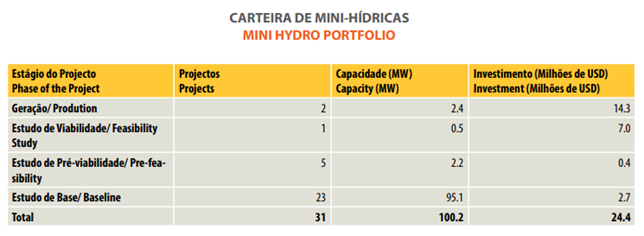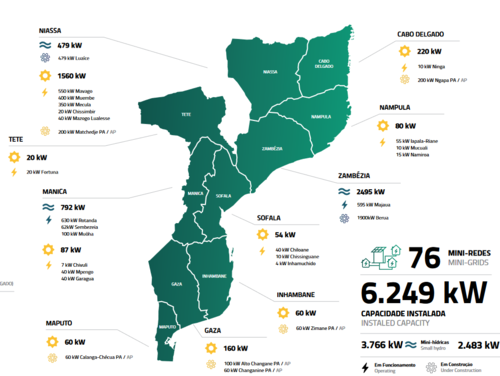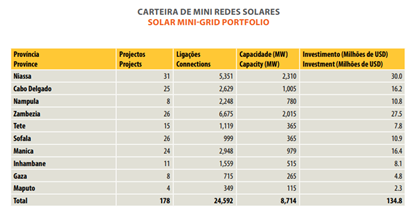Knowledge fuels change - Support energypedia!
For over 10 years, energypedia has been connecting energy experts around the world — helping them share knowledge, learn from each other, and accelerate the global energy transition.
Today, we ask for your support to keep this platform free and accessible to all.
Even a small contribution makes a big difference! If just 10–20% of our 60,000+ monthly visitors donated the equivalent of a cup of coffee — €5 — Energypedia would be fully funded for a whole year.
Is the knowledge you’ve gained through Energypedia this year worth €5 or more?
Your donation keeps the platform running, helps us create new knowledge products, and contributes directly to achieving SDG 7.
Thank you for your support, your donation, big or small, truly matters!
Nano/Mini-Grid Market Size and Growth Potential in Mozambique
Introduction
Along with grid-densification and access to solar home systems (SHS), one of the most important measures to achieve country-wide electrification in Mozambique by 2030 is through the development of mini-grids. The mini-grid market for private sector is still small in Mozambique. Regulatory restrictions limit the participation of the private sector to develop mini-grid projects. Unlike the market for Solar Home Systems (SHS) and Improved Cookstoves (ICS), which are targeted at individual users, namely a household or institution, mini-grids provide access to electricity to a larger number of end-users simultaneously. Read more...
This article provides a snapshot of the mini-grids market in Mozambique with a focus on the market size and growth potential of mini-grids in Mozambique
Market Size and Growth Potential
This study from the Green Mini-grid Programme (GMG) analysed the population density and planned grid network to identify areas with the greatest mini-grid potential in Mozambique.
As shown in Figure 1, the mini-grid market size is estimated to be around USD 63.2 million, reaching 5.3 million off-grid population. This market size targets customers who are living 15 km away from the grid and have a monthly household energy expenditure of 327 MZN. The greatest potential for mini-grids is found to be in Maputo and Zambezia province. Figure 2 shows the mini-grid sites plotted against population density and transmission lines[1].
 Figure 1: Estimated mini-grid market Size[1] |
 Figure 2: Mini-grid sites plotted against population density and transmission lines[1] |
The table below provides an overview of the demographics, electrification rate and social infrastructures in the 11 Mozambican provinces (based on 2017 census data)[2][3].
| Province | Population | Households | Area (SqKm) | Electrified population (%) | Monthly energy expenditure (USD) | Poverty rate (%) | Schools | Health centers | % of Mobile network coverage |
| Nampula | 5,758,902 | 1,151,800 | 77.953 | 23 | 4.1 | 64.8 | 244 | 200 | 75% |
| Cabo Delgado | 2,320,261 | 464,066 | 77,807 | 22 | 7.1 | 50 | 375 | 114 | 73% |
| Manica | 1,945,982 | 389,182 | 62.273 | 25 | 6.7 | 37.2 | 410 | 104 | 78% |
| Sofala | 2,259,248 | 451,842 | 67,664 | 34 | 5.4 | 49.6 | 75 | 232 | 58% |
| Zambezia | 5,164,726 | 1,032,961 | 102,884 | 10 | 4.1 | 61.8 | 1224 | 229 | 63% |
| Niassa | 1,810,803 | 362,161 | 122,342 | 19 | 5.8 | 66.7 | 110 | 160 | 68% |
| Tete | 2,648,949 | 529,790 | 99,299 | 14 | 7.1 | 41.9 | 71 | 129 | 73% |
| Gaza | 1,422,458 | 284,517 | 75,131 | 30 | 6.3 | 43.6 | 578 | 140 | 77% |
| Maputo | 1,968,889 | 393,774 | 22,981 | 78 | 15.9 | 11.8 | 357 | 111 | 46% |
| Inhambane | 1,488,685 | 297,745 | 68,351 | 15 | 6.6 | 34.5 | 2 | 129 | 69% |
| Maputo City | 1,120,869 | 224,175 | 331 | 100 | 15.9 | 11.8 | 0 | 39 | 100% |
Mini-grid Projects (Planned, Under Construction or in Operation)
The map below shows the 76 mini-grid projects with an installed capacity of 6.2 MW and are either in operation or under construction by FUNAE[4].
As part of the Energy for All ProEnergia Project, FUNAE identified 13 potential sites in northern Mozambique for the construction of combined solar PV and battery storage projects from the portfolio. These projects are expected to add a capacity of 2,6 MW. The Energy for All ProEnergia Project aims to construct up to six mini-grids from those 13 sites depending on the success of the PPP approach[5].
The 2019 portfolio by FUNAE also features 31 hydro mini-grid project opportunities with a total potential of 100.2 MW, and 187 solar mini-grid projects adding up to a capacity of 8.7 MW[6].
Here you can find the complete 2019 portfolio by FUNAE. The portfolio shows the potential sites identified by FUNAE for mini-grids using different RE sources.
Potential Mini-Hydro Sites
The 31 projects mentioned in FUNAE’s Renewable Energy Projects Portfolio (2019) are in Niassa, Nampula, Zambézia, Tete and Manica provinces. As shown in the following table, out of the 31 potential project sites, 2 are already secured for generation but are waiting for investments for the distribution network. The feasibility study for one other project located in Manica is completed. For 5 other projects the pre-feasibility study has been completed. For the remaining 23, baseline studies have been conducted at each of the sites to determine the hydro potential[6].

Potential Solar Mini-grid Sites
The atlas has identified 178 solar mini-grid projects for the development of mini-grids with a total capacity of 8.7 MW. As shown in the table below, the coverage of the projects include all provinces of the country. Niassa is the province with the most analysed sites[6].
Further Information
References
- ↑ 1.0 1.1 1.2 SEforALL Africa Hub, ‘Green Mini Grid Market Development Programme’, 2017, https://www.aler-renovaveis.org/contents/lerpublication/afdb_2017_abr_mini-grid-market-opportunity-assessment-mozambique.pdf.
- ↑ USAID. “Mozambique Route-to-Market Tool,” 2020. https://dec.usaid.gov/dec/GetDoc.axdctID=ODVhZjk4NWQtM2YyMi00YjRmLTkxNjktZTcxMjM2NDBmY2Uy&pID=NTYw&attchmnt=VHJ1ZQ==&rID=NTU5NDcy.
- ↑ USAID (2022). Mozambique route to market (RTM) tool. https://pdf.usaid.gov/pdf_docs/PA00XGZT.pdf
- ↑ ALER, ‘Renováveis Em Moçambique’, 2021, https://www.lerenovaveis.org/contents/lerpublication/aler_mar2021_resumo-renovaveis-em-mocambique-2021.pdf.
- ↑ ‘Mozambique Energy for All ProEnergia Project.Pdf’. Accessed 14 June 2021. https://documents1.worldbank.org/curated/pt/594061554084119829/pdf/Mozambique-Energy-for-All-ProEnergia-Project.pdf.
- ↑ 6.0 6.1 6.2 6.3 ‘Carteira-de-Projectos-de-Energias-Renovaveis-2019-Final.Pdf’. Accessed 28 June 2021.https://www.aler-renovaveis.org/contents/files/carteira-de-projectos-de-energias-renovaveis-2019-final.pdf.





















